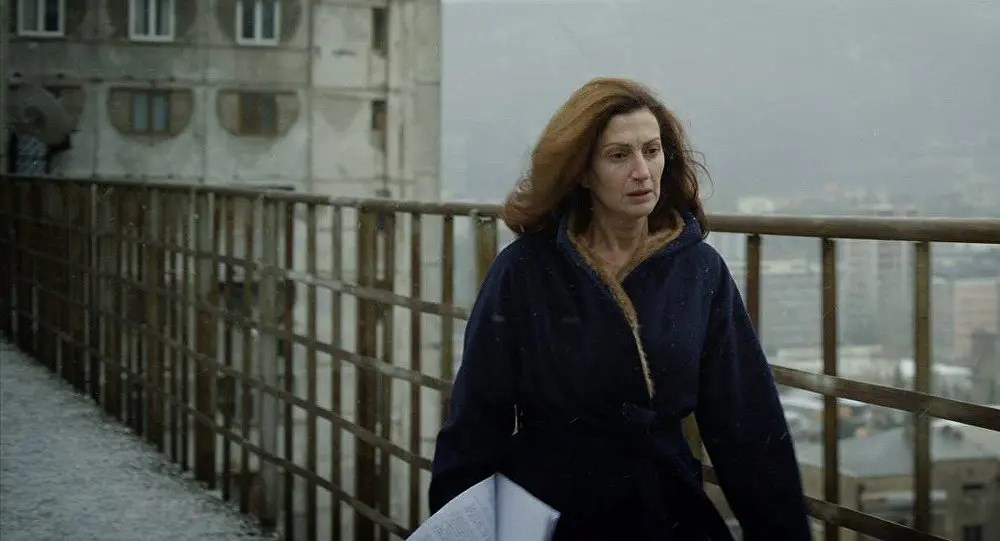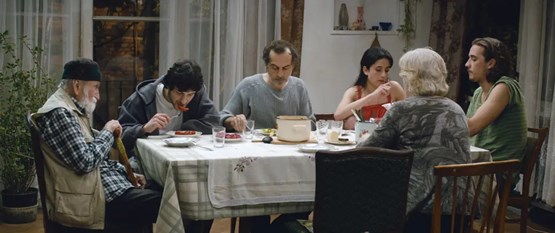
Scary Mother
In her essay titled A Room of One’s Own Virginia Woolf writes: “…give her a room of her own and five hundred a year, let her speak her mind and leave out half that she now puts in, and she will write a better book one of these days.”
Like Woolf’s contemporary women, the main character of Ana Urushadze’s film Scary Mother doesn’t have her own room. Instead, she has an “understanding” husband who lets his wife use the common room to write her book.
Manana, the main character in the film is a middle-aged woman, who’s busy from morning till evening looking after her family. The action takes place in Tbilisi in late autumn or early winter. An old bridge that connects the well-known, gray, non-descript apartment houses of the city is often seen in the film (this post-Soviet aesthetic and its associated exoticism is especially attractive to western viewers). Manana walks across that bridge everyday carrying a bag full of groceries. Her life has become a ritual of the mundane: she wakes up early every morning, buys groceries, collects both her husband’s and children’s dirty socks – washes, cleans, and prepares dinner… repeat. Throughout this mundane ritual, Manana is writing a book, which gives viewers their first clue that the film is about a woman fighting to have her own life too.
Manana is alone and nobody understands her. Her frank conversations and strange dreams make her husband uneasy. Her only friend is the owner of a stationery shop, who believes in Manana’s special talent and refers to Manana’s book is a “literary masterpiece”. Manana lets her husband read her book as well. On another grey day, the entire family stands together on the balcony, silently looking at the book’s pages burning in a pail – Manana’s husband is burning her book.
The husband wants something different from her and demands she “look after herself”, comb her hair, buy new clothes, which he pays for himself. Sympathy of the viewers towards the woman is growing, because she’s not allowed to treat her appearance as she wishes; to comb her hair, shave or wash her body when she wishes to do.
But Manana is punished for verbalizing her subconscious world. Throughout the story, the film director tries to explain the characters’ actions and their problems through psychoanalysis, which is a difficult road to navigate.Unfortunately, the film fails to fully show it. The vagueness even creates a kind of artificial estrangement among the viewers, because they don’t fully understand her, and instead remain indifferent to the woman who is being bullied. With her confused nature and imbalanced, hysterical demeanor, Manana creates a stereotypical image of an artist who is actually “required” to be inadequate and different, which may even be demonstrated through a lack of personal hygiene.
It’s always hard to talk about one’s own past; childhood traumas and unconscious wishes, especially with regard to one’s own parents, who, in most cases, are participants or causes of those traumas and pains in the first place. For example, Polish film director Krzysztof Kieślowski uses a non-verbal method in this way.
At the end of the fourth part of Decalogue, which is about a father-daughter relationship, the father and daughter are alone in an elevator. The elevator moves between the floors from top to bottom and vice-versa. They don’t speak among themselves, they simply follow the movement. Metaphorically, they go deep into their own subconscious, which is as dark and dirty as the high-rise’s basement where the elevator finally arrives.
The final scene of Scary Mother also shows the father and his daughter. They meet each other in the capacity of “author” and“translator”. This main dialogue between the two revokes the past; they try to sort out their relations. However, their dialogue has a pronouncedly pathetic and official tone and they fail to adequately conveyto the viewers the unusual distance between them.
The movie suddenly contains scenes from a theater play. Georgian actors often have a hard time showing everyday life in a film. With their excessive mannerisms and expressiveness, they only become more artificial and the problems they are discussing, which are part of our everyday lives, lose their acuteness in that exaggerated scene, they can’t touch us anymore.
Scary Mother is Ana Urushadze’s first full-length film. It was a project that won the competition announced by the National Cinema Center. It has also won in the Best Debut category at the Locarno Film Festival. Having already garnered positive international press, Scary Mother’s festival shelf-life is not over. Festival audiences will most probably gloss over the film’s shortcomings mentioned above. The excessive pathos, sensitivity and artificiality of the dialogue is hidden behind the subtitles (Georgian viewers won’t be so easily fooled however). The movie’s visuals are also attractive – scenes filled with non-descript, grey cityscapes and the specific method of editing – short, fragmented shots, and shots that resemble a photo album are compelling. Such aesthetics makes the film’s already serious plot even heavier, which, as I have already mentioned above, is well liked at European festivals.
The story of a woman in search for herself by confronting her family is probably an interesting plot for the jury – especially if we take into consideration the fact that the film’s director is a young woman from a country where women’s oppression is not an uncommon occurrence.
Finally, it can be said that the film justifies its title – Manana is really a scary mother, it’s just unclear why she had to be so scary.
Actress, Nato Murvanidze won the award for Best Performance by an Actress at the 2017 Asia Pacific Screen Awards.
ეს სტატია მხოლოდ გამომწერებისთვისაა. შეიძინე შენთვის სასურველი პაკეტი
We Recommend




